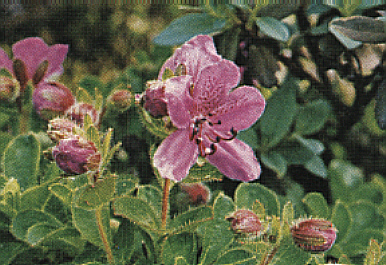QBARS - v31n2 Rhododendron camtschaticum
Rhododendron camtschaticum
Arthur P. Dome, Seattle Chapter

|
|
R. camtschaticum
Photo by Arthur P. Dome |
Rhododendron camtschaticum is one of the real little jewels of the genus. It has a uniqueness and personality all its own. Those of you who have had the opportunity to view it in a thriving situation will admit it has the qualities for earning itself a position in anyone's garden which has a location for it.
In the Pacific Northwest it seems to do well in rockery plantings or in semi-woodland situations where it can get ample sunlight and still maintain a relative cool, damp condition for its roots.
I can remember it flowering on Adak Island in the Aleutians, its tiny-type growth entangled with the other plant life of the tundra. A few years back I had the opportunity to observe it growing on the hills on Kodiak Island. My trip was not at a time suitable for collecting seeds or live plant material but it seemed worth it, even to the point of getting soaked, to see it growing in its natural habitat again.
Rhododendron camtschaticum grows to about six inches tall and where it has no competition from other plants it forms little cushions that soon spread into larger mats.
Its new growth is particularly interesting with the veins and margins of the leaves as well as the stems being very bristly or hairy. The color of the foliage seems to appear a deeper green where it can enjoy a rich, cool root run as compared to the olive-green it has in a gritty media with a wide open environment. The flower buds are unique as they appear like little green balls with a lot of pins sticking out of them.
This is the only rhododendron I know of that blooms on the current season's growth. It produces many rosy-purple to rose-colored blooms that are speckled on the face with darker spots. These are born on upright branchlets that shoot up from the trailing main stems.
It is usually considered deciduous and those not familiar with this characteristic might feel they have lost it and find themselves removing it from their garden with the fall or winter clean up.
R. camtschaticum propagates readily from seed or by removing some of the underground root stocks that shoot up here and there as the plant spreads. I have sown seed in late November and have had the plants up with from six to eight true leaves by the end of February. This did require supplemental lighting and feeding.
This last autumn, while in Alaska, I had the opportunity to make the acquaintance of a very gracious lady who has a small plant of a white R. camtschaticum that was collected on Kodiak Island. Her very fine colored slides showed it to be as white a white as any white could be. I felt extremely fortunate when she shared some of the seed from this rare little jewel with me, especially since this was the first time it had flowered for her.
Most of the seed has germinated now with many of the little plants showing six to eight true leaves and so far no problems. My next concern is - how much attention should I pay to those that claim all or most of these seedlings will revert to form and flower in shades of rose to rose-purple rather than having the nice white blooms of the parent plant. I guess the only answer is to keep custody of all of them until they bloom and find out for myself.
